
- •Contents
- •Unit I water
- •Text 1a water in human life
- •Text 1b
- •Text 1c
- •Unit II ports
- •Text 2a
- •Text 2b
- •Text 2c
- •Unit III world shipping
- •Text 3a
- •Text 3b
- •Text 3c
- •Unit IV water ecology
- •Vocabulary.
- •Text 4a
- •Text 4b
- •Text 4c
- •Unit V early history of shipbuilding
- •Vocabulary:
- •Text 5a
- •Text 5b
- •Text 5c
- •Unit VI full-riggers
- •Text 6a
- •Text 6b
- •Text 6c
- •Unit VII steam power
- •Text 7b
- •Text 7c
- •Unit VIII great britain as a sea-faring nation
- •Text 8a
- •Text 8b
- •Text 8c
- •Supplemantary texts
- •Abbreviations
- •Geographical and proper names
- •Vocabulary
Vocabulary:
-
The roof of the building is supported by several columns. 2. Different goods are carried by cargo ships. 3. The hull boards of this old boat are still strong. 4. The ancient Roman ship could carry about 900 tons of cargo. 5. Ancient sailors were very brave men to sail overseas without various machines and apparatus. 6. The Mediterranean galleys mostly had triangular sails. 7. In his poem Byron poetized the sea and ships. 8. The circulation of goods accomplished through this port is really huge. 9. The planks of this ancient ship are still in an excellent state. 10. After a long journey the expedition reached the port. 11. Regular cargo delivering from the colonies enriched the economy of Great Britain.
Ex. 4. Define in one word.
-
a cargo or merchant ship that could be hired by a trader for delivering his goods overseas;
-
a back part of a ship where the steering oar was situated;
-
side parts of a ship skeleton;
-
an ancient warship, having several rows of oarsmen, one sail, and a ram at the waterline in the front;
-
a marine unit of velocity;
-
a room on board aimed for passengers or ship officers;
-
the outer covering of the hull;
-
the ancient Scandinavian ship with a bow in a form of a fabulous animal;
-
carrying cargoes and goods by ships;
-
a small ship, usually with one mast, having castle-like superstructures on the bow and stern;
-
a natural or artificial bay, the ships’ shelter.
Ex. 5. Translate into Russian:
date back approximately
a skeleton of keel and ribs
the Mediterranean region
small graceful canoes
by means of
all we know for sure
heavy freighters
seagoing sailing ship
sturdy and roomy
outstanding achievement
the bow and stern
an average speed
enormous stone pillars
across the deck
a line of oarsmen
true seafaring people
marine history
a high structure called a castle
naval shipbuilding
a new kind of steering apparatus
world glory
much stronger than oars
worth-mentioning
winds blowing from behind
the terror of the seas
sailing into the wind
a well-preserved example
mounted on a mast
to carry larger shipments
the standard merchant vessel
rough seas and high winds
wide clinker-built hulls
bulky cargoes
Ex. 6. Read and translate the text:
Text 5a
ANCIENT SHIPS
The age of sailing ships began with the invention of the sail and the vessel built of planks. The first examples can be traced up to the ancient Egypt. They date back approximately to 3000 BC.
The ancient Egyptians designed many kinds of vessels, including small graceful canoes, beautiful yachts and heavy freighters. Their most outstanding achievement was probably the huge barges that carried enormous stone pillars from quarries up the Nile River. The biggest barges measured more than 200 ft (61 m) long and carried 700 t of cargo.
O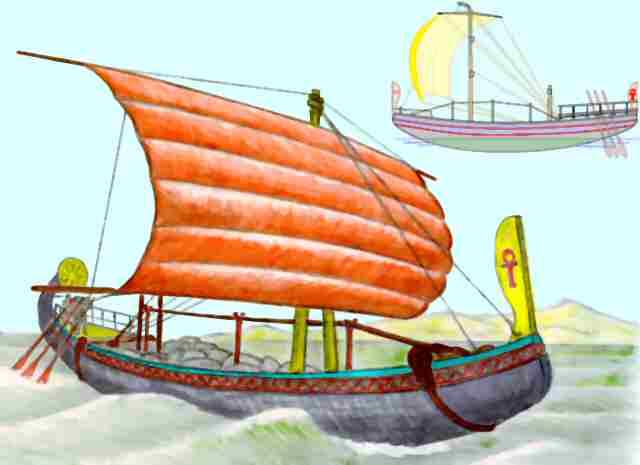 ne
sail and a line of oarsmen on each side propelled the yachts and
other light Egyptian vessels. The heavier craft were driven by
only a sail. The Egyptians used a rectangular or square sail, which
at first was tall and narrow. But after 2000 BC, they made it much
wider than it was tall. The Egyptians steered their ships with large
oars on each side near the stern.
ne
sail and a line of oarsmen on each side propelled the yachts and
other light Egyptian vessels. The heavier craft were driven by
only a sail. The Egyptians used a rectangular or square sail, which
at first was tall and narrow. But after 2000 BC, they made it much
wider than it was tall. The Egyptians steered their ships with large
oars on each side near the stern.
The Egyptians built their vessels chiefly for use on the Nile. As a result, they made all their craft rather light. Boats of planks are built by first making a skeleton of keel and ribs and then fastening the planks of the hull to the ribs.
But the Egyptians built their river craft without keel or ribs. They simply fitted the planks together by means of joints to form the hull. These vessels were too weak for the Pic. 3. Light Egyptian Papyrus Vessel sea, though Egyptian seagoing ships probably had some kind of keel and a few ribs. The bow and stern of these ships tended to droop, so sailors wound a heavy rope around the bow, stretched it tightly across the deck and looped it around the stern. This strengthened the vessels and kept the bow and stern from sagging. The Egyptians sailed mainly on the Red Sea and along the eastern shore of the Mediterranean.
The
Minoans, who lived on the island of Crete, became the first true
seafaring people of the Mediterranean region. As early as 2500 BC,
their ships ranged the eastern Mediterranean and as far west as the
island of Sicily. About 1450 BC, the Mycenaeans, who lived on what
is now the Greek mainland, won control of the sea. Both these
n
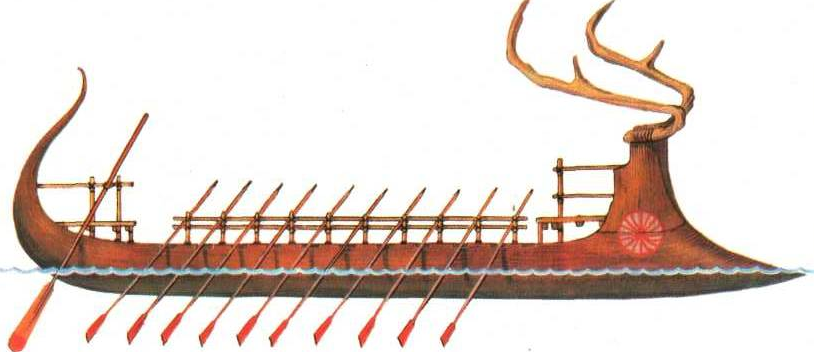
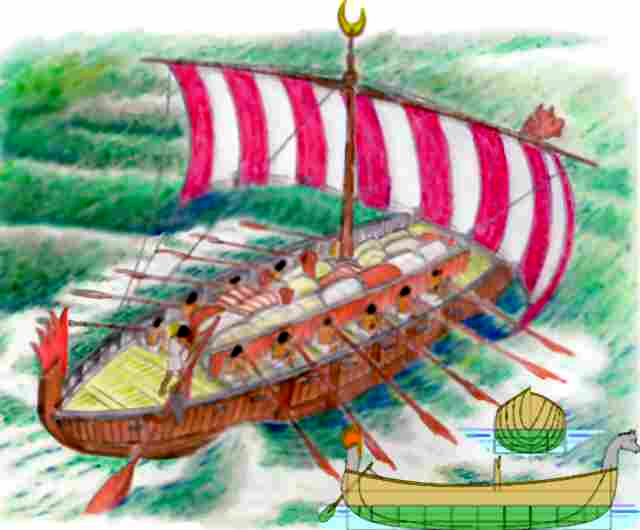 About
1200 BC the leading seafaring peoples in the Mediterranean became
the Phoenicians, who lived along the eastern shore, and the Greeks.
They built broad, roomy cargo ships and greatly improved the ship
rig. By about 500 BC, they built vessels with two masts. The second
mast sloped forward over the bow. It supported a small Pic.
5. Phoenician Trade Vessel
square sail that made steering easier. After 300 BC, the
Greeks set a triangular sail above the mainsail and added another
square sail near the stern on their biggest ships.
About
1200 BC the leading seafaring peoples in the Mediterranean became
the Phoenicians, who lived along the eastern shore, and the Greeks.
They built broad, roomy cargo ships and greatly improved the ship
rig. By about 500 BC, they built vessels with two masts. The second
mast sloped forward over the bow. It supported a small Pic.
5. Phoenician Trade Vessel
square sail that made steering easier. After 300 BC, the
Greeks set a triangular sail above the mainsail and added another
square sail near the stern on their biggest ships.
This simple four-sail rig was the most advanced one ever developed by the peoples of ancient times. As a result, ancient ships were slow and could travel at an average speed of only about 5 knots with the wind. The standard Greek freighter measured about 100 ft (30 m) long and could carry from 90 to 180 t of cargo.
For warships the Phoenicians and Greeks used galleys, driven by oars.
After 1000 BC, a large, sharp ram was added to the prow at the waterline for use in battle. By about 700 BC, the Phoenicians built biremes, galleys with two banks (rows) of oarsmen on each side. The Greeks adopted these ships, made them lighter and faster and, by 500 BC, developed the trireme with three banks of rowers.
G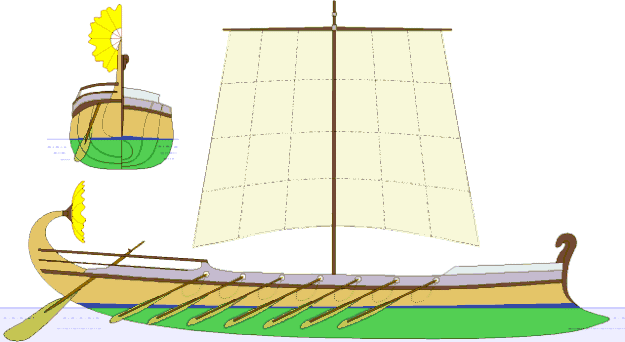 reek
- and later Roman – ships had stronger hulls than Egyptian ones
because of using more and tighter joints to fit the planks and
inserting of a system of ribs to stiffen the hull.
reek
- and later Roman – ships had stronger hulls than Egyptian ones
because of using more and tighter joints to fit the planks and
inserting of a system of ribs to stiffen the hull.
The Romans used chiefly the same kinds of ships as the Greeks did and during the 100’s BC became the rulers of the Mediterranean. They Pic. 6. Ancient Greek Galley built up the largest merchant fleet of ancient times. Their largest cargo ships measured up to 180 ft (55 m) long and
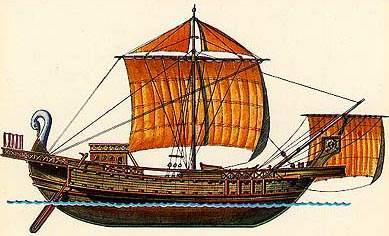
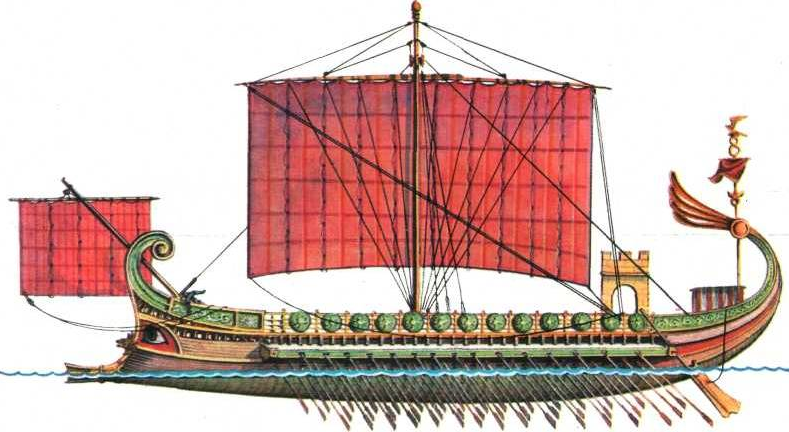
Ex.7. Answer the questions:
1. When did the age of sailing ships begin? 2. What kinds of vessels did the ancient Egyptians design? 3. What was their most outstanding achievement? 4. How were the Egyptian craft propelled? 5. Why were the Egyptian vessels unsuitable for the sea? 6. What were the first true seafaring people of the Mediterranean region? 7. Who won control of the sea about 1450 BC? 8. What do we know about their ships? 9. What improvements in shipbuilding were made by the Phoenicians and Greeks? 10. What types of galleys were there in the ancient world? 11. Can we say that trade was well developed in ancient Rome? Give your reasons. 12. Were there special passenger vessels in the ancient times? How were the travelers carried?
Ex. 8. Agree or disagree with the following statements. Give grounds to your answer:
1. The first examples of the sailing ships date back to the times of Pharaohs. 2. The ancient Egyptian ship-builders could design cargo ships only. 3. The Egyptian ships were propelled by a system of sails. 4. The Egyptians were skilled sea-goers. 5. The Egyptian ships were strengthened by means of a simple rope. 6. We can say that the first true seafaring peoples were essentially the Greeks. 7. The vessels with two masts were designed by the Romans. 8. The difference between the galleys of various types was chiefly in number and position of oarsmen. 9. On board the ships ancient travelers lived in comfortable cabins. 10. The ram is a kind of the mast.
Ex. 9. Translate into English:
1. В древнем Египте огромные каменные колонны доставлялись с каменоломен на баржах, которые, возможно, были самым большим достижением египетских корабелов. 2. Легкие суда, вроде яхт, приводились в движение с помощью гребцов или паруса, в то время как на более тяжелых кораблях использовался только парус. 3. Нос и корма у египетских кораблей укреплялись толстой веревкой, протянутой через палубу. 4. Мы знаем наверняка, что минойские грузовые корабли были прочными и вместительными. 5. Греческие военные корабли были легче и быстрее, чем финикийские, и имели более прочный корпус. 6. Из-за простого такелажа средняя скорость кораблей была около 5 узлов при попутном ветре. 7. Самый большой торговый флот древнего мира был построен римлянами. 8. Во время путешествия, если погода хорошая, я предпочитаю проводить время на палубе, а не в каюте.
Ex. 10. Speak on the different types of the ships using the pictures and text material.
Ex. 11. Define the main topic and idea of the text, split it into the logical parts, make up the plan of the text.
Ex. 12. Abstract the text.
Ex. 13. Read and try to understand the text:
